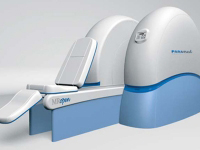Pain and waiting not an option
Vancouver Coastal Health Research Institute (VCHRI) researcher Erin Macri is uncomfortable with the idea that unbearable pain requiring surgery is currently the standard for treating osteoarthritis of the knee.
“The long, painful delay before knee surgery is inevitable because of the limited life span of artificial joints, but there has to be a better way to treat this condition than waiting until your quality of life is terrible enough to warrant total knee replacement,” says Macri, a PhD trainee under the supervision of Dr. Karim Khan at the Centre for Hip Health and Mobility (CHHM).
Macri’s PhD focus is on degeneration of the knee cap, called patellofemoral osteoarthritis, and her goal is to use cutting edge technology of the Upright Open MRI to better understand the relationship between knee alignment and arthritis while research participants are standing up.
“The Open MRI allows us to use creative positioning to look at how knee alignment potentially is a risk factor for the onset or progression of arthritis,” says Macri. “It is exciting to be able to see patients’ knees in potentially pain-provoking positions during weight bearing tasks like standing or squatting rather than through traditional MRIs in which the patient is lying down.”
“From a methodological standpoint, I hope to create protocols that can be used to look at all varieties of knees. Observational studies like this can guide us in developing innovative strategies for treating the condition that could delay or prevent the need for surgery entirely,” Macri says.
Many knee caps are positioned abnormally and this poor alignment is believed to be a major cause of osteoarthritis onset and progression. Research has shown that osteoarthritis of the knee cap causes more pain and disability than the rest of the knee and eventually progresses to affect the entire knee. In other words, knee arthritis may actually start at the knee cap.
“At the moment we don’t have a lot of options for effectively treating osteoarthritis of the knee,” Macri adds. “But I feel hopeful now that with people using MRI to study the onset of the disease we will learn much more in the coming years.”

